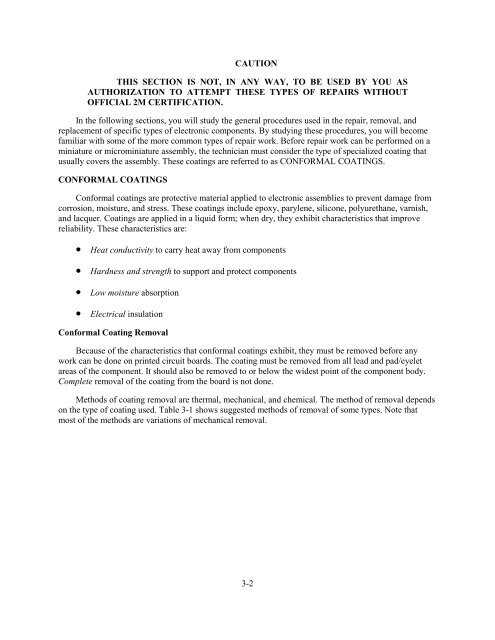Navy Electricity and Electronics Training Series - Historic Naval ...
Navy Electricity and Electronics Training Series - Historic Naval ...
Navy Electricity and Electronics Training Series - Historic Naval ...
You also want an ePaper? Increase the reach of your titles
YUMPU automatically turns print PDFs into web optimized ePapers that Google loves.
CAUTIONTHIS SECTION IS NOT, IN ANY WAY, TO BE USED BY YOU ASAUTHORIZATION TO ATTEMPT THESE TYPES OF REPAIRS WITHOUTOFFICIAL 2M CERTIFICATION.In the following sections, you will study the general procedures used in the repair, removal, <strong>and</strong>replacement of specific types of electronic components. By studying these procedures, you will becomefamiliar with some of the more common types of repair work. Before repair work can be performed on aminiature or microminiature assembly, the technician must consider the type of specialized coating thatusually covers the assembly. These coatings are referred to as CONFORMAL COATINGS.CONFORMAL COATINGSConformal coatings are protective material applied to electronic assemblies to prevent damage fromcorrosion, moisture, <strong>and</strong> stress. These coatings include epoxy, parylene, silicone, polyurethane, varnish,<strong>and</strong> lacquer. Coatings are applied in a liquid form; when dry, they exhibit characteristics that improvereliability. These characteristics are:• Heat conductivity to carry heat away from components• Hardness <strong>and</strong> strength to support <strong>and</strong> protect components• Low moisture absorption• Electrical insulationConformal Coating RemovalBecause of the characteristics that conformal coatings exhibit, they must be removed before anywork can be done on printed circuit boards. The coating must be removed from all lead <strong>and</strong> pad/eyeletareas of the component. It should also be removed to or below the widest point of the component body.Complete removal of the coating from the board is not done.Methods of coating removal are thermal, mechanical, <strong>and</strong> chemical. The method of removal dependson the type of coating used. Table 3-1 shows suggested methods of removal of some types. Note thatmost of the methods are variations of mechanical removal.3-2

















